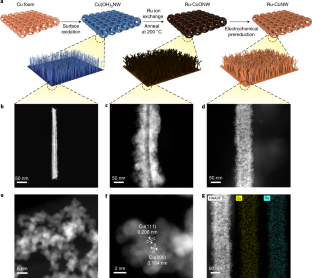2022-05-02 アメリカ合衆国・ライス大学

・ ライス大学、アリゾナ州立大学およびパシフィックノースウェスト研究所(PNNL)等から成る研究チームが、工業廃水や汚染された地下水に含まれる低濃度の硝酸塩を高効率でアンモニアに変換する高性能の電気化学触媒を開発。
・ 銅ナノワイヤメッシュとルテニウム原子で構成される新電解触媒は、2,000ppm レベルの硝酸塩を100%に近い効率でアンモニアに変換する。ストリッピング処理によるアンモニア回収後に残る窒素含有量は、世界保健機構(WHO)が定める「飲料可能」なレベルとなる。さらに他の汚染物質を処理することで、産業排水から飲料水への変換の可能性も期待できる。
・ 新触媒プロセスは、年間 1.7 億トン超のアンモニアを生産するエネルギー集約的なプロセスに依存する産業界に効率的な代替手法を提供するもの。過去の研究で硝酸還元でのルテニウムの有効性を確認していたが、水素発生反応(HER)との競合の課題があった。
・ CO2 還元で HER を抑制する銅とルテニウムとの効果的な組み合わせ方を模索し、銅のマトリクスにルテニウム原子を高度に分散させた触媒が最も優れた機能を提供することを確認した。
・ 密度汎関数法(DFT)により、硝酸塩とアンモニアを結ぶ化学経路を容易に交差させるルテニウム原子の働きを解明。高分散ルテニウム原子が活発な硝酸還元部位を提供し、周囲の銅が HER を抑制する。
・ 室温・大気圧下、触媒反応速度の最大化に不可欠な産業レベルの電流量の 1A/㎠ で作動。理想的な電流密度を達成しながら、低濃度硝酸塩での優れた選択性を実証した。大規模なインフラは不要のため、産業アプリケーションへの展開が見込める。
・ 新触媒プロセスの主要な利点は、世界の年間 CO2 排出量の 1.4%を占める、従来のアンモニア工業生産での CO2 排出削減効果。新触媒プロセスが既存のアンモニア産業を短期間で完全に代替することはないが、特に硝酸塩が大量にある環境においてアンモニア生産手段の分散化に大きく貢献する。
・ ライス大学では、硝酸還元によりアンモニアを合成して廃水の脱硝に期待できる、3D 炭素繊維ペーパーにコバルト-銅ナノ粒子を担持した、効率的で低コストの触媒を別途開発している。
・ 本研究は、米国立科学財団(NSF)の Nanosystems Engineering Research Center for Nanotechnology
Enabled Water Treatment およびウェルチ財団が支援した。
URL: https://news.rice.edu/news/2022/rice-process-aims-strip-ammonia-wastewater
<NEDO海外技術情報より>
関連情報
Nature Nanotechnology 掲載論文(アブストラクトのみ:全文は有料)
Efficient conversion of low-concentration nitrate sources into ammonia on a Ru-dispersed Cu nanowire electrocatalyst
URL: https://www.nature.com/articles/s41565-022-01121-4
Abstract
Electrochemically converting nitrate ions, a widely distributed nitrogen source in industrial wastewater and polluted groundwater, into ammonia represents a sustainable route for both wastewater treatment and ammonia generation. However, it is currently hindered by low catalytic activities, especially under low nitrate concentrations. Here we report a high-performance Ru-dispersed Cu nanowire catalyst that delivers an industrial-relevant nitrate reduction current of 1 A cm–2 while maintaining a high NH3 Faradaic efficiency of 93%. More importantly, this high nitrate-reduction catalytic activity enables over a 99% nitrate conversion into ammonia, from an industrial wastewater level of 2,000 ppm to a drinkable water level <50 ppm, while still maintaining an over 90% Faradaic efficiency. Coupling the nitrate reduction effluent stream with an air stripping process, we successfully obtained high purity solid NH4Cl and liquid NH3 solution products, which suggests a practical approach to convert wastewater nitrate into valuable ammonia products. Density functional theory calculations reveal that the highly dispersed Ru atoms provide active nitrate reduction sites and the surrounding Cu sites can suppress the main side reaction, the hydrogen evolution reaction.



